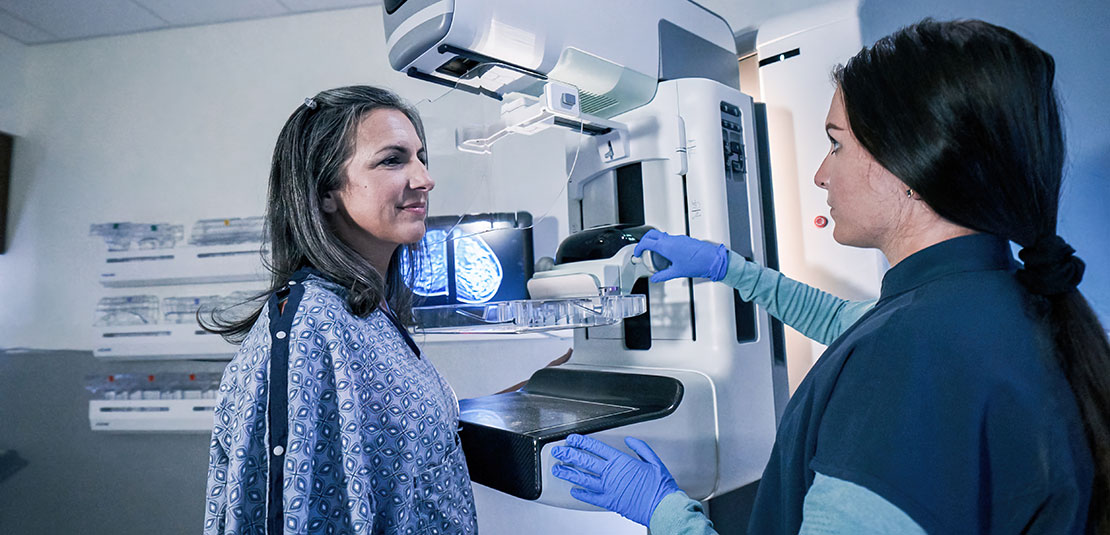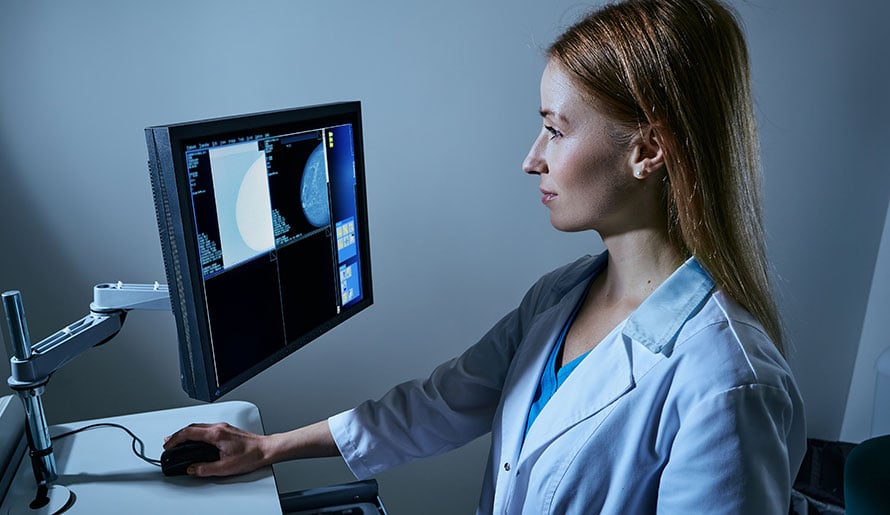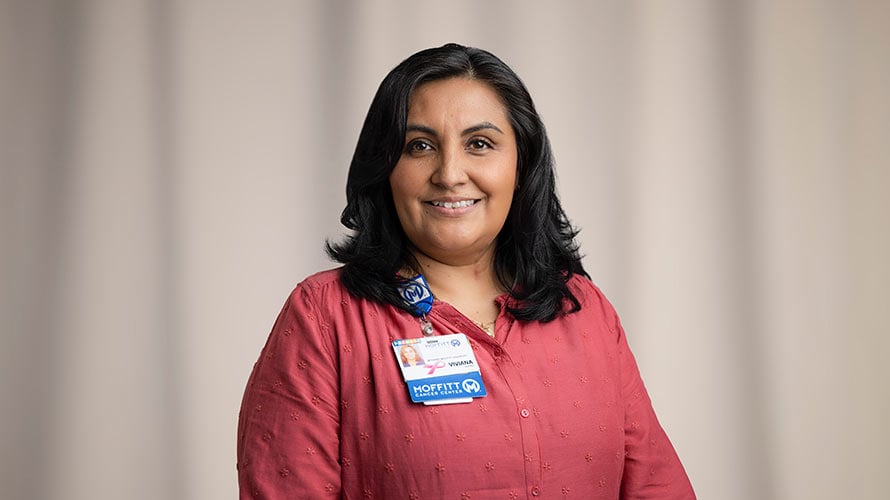What to Do If You Find a Lump in Your Breast

“I found a lump on my breast and it hurts; what should I do?” The breast specialists in the Don & Erika Wallace Comprehensive Breast Program at Moffitt Cancer Center can expertly address this and other frequently asked questions about breast cancer. Finding a lump in your breast can be distressing and it is natural to feel a surge of powerful emotions. We understand your concerns, and our experienced and compassionate team is here for you. To help you navigate the situation calmly, proactively and effectively, we suggest taking this structured approach:
Stay calm and assess the situation
If you find a lump in your breast, there is no need to panic. Instead, take a deep breath and remember: Breast lumps are common and the vast majority are benign. Only a trained healthcare professional can make that crucial determination, but you can help by gathering some information before your consultation. For instance, make a note of when and how you discovered the lump as well as its size, texture and any associated pain. Also, be prepared to discuss your personal and family medical history, and create a list of any medications, hormones or supplements that you are taking now or have taken in the past. This valuable information can be helpful to your physician when evaluating your breast lump.
Seek professional guidance
Promptly schedule an appointment with a healthcare provider, such as your primary care physician or a breast specialist at Moffitt. Breast cancer is highly treatable, and a timely and accurate diagnosis is the key to achieving the best possible outcome and quality of life. Your physician can perform a thorough physical examination focused specifically on your breast lump. To aid in their assessment, you can offer detailed information about your own findings.
Complete any breast imaging tests recommended by your physician
It is impossible—even for a physician—to distinguish a noncancerous breast lump from a cancerous tumor based solely on how it feels, e.g., whether it is hard or soft, painful or painless, mobile or stationary. Therefore, your physician will likely order diagnostic imaging tests to obtain a clearer picture of the lump and better understand its characteristics.
Moffitt offers the latest options in breast imaging, including:

Digital mammography
Using innovative technology and a low-dose X-ray system, a certified technologist at Moffitt will capture multiple images of the affected breast. The images will be recorded electronically in a digital format rather than directly onto film. A board-certified radiologist will then interpret the digital mammography images using computer-aided detection (CAD).
Full-breast tomosynthesis
Also known as 3D mammography, full-breast tomosynthesis is an advanced X-ray imaging technique that captures sectional images of the affected breast, which are then reconstructed into a three-dimensional depiction of the breast for heightened clarity. Within a few seconds, a certified technologist will move the X-ray tube on a circular arch while making a series of low-dose exposures from different angles.
Breast magnetic resonance imaging (MRI)
Using specialized imaging technology that incorporates powerful magnets and radio waves, a certified technologist will create highly detailed, cross-sectional images of the affected breast. Often used as a supplementary imaging tool, breast MRI can provide valuable information to aid a physician in evaluating a breast abnormality beyond what traditional mammography may reveal.
Automated breast ultrasound system (ABUS)
Using specialized imaging technology that incorporates sound waves, a certified technologist at Moffitt will create detailed, three-dimensional images of the affected breast. ABUS is often used as a supplementary imaging tool for evaluating women who have dense breast tissue, which may obscure abnormalities in images.
Have a biopsy if needed
To determine whether your breast lump is cancerous or benign, your physician may recommend a biopsy. This procedure involves taking a small sample of the suspicious tissue for microscopic evaluation by a pathologist, who can identify breast cancer cells. A biopsy can provide a definitive diagnosis and, if necessary, guide the development of an individualized treatment plan.
Moffitt offers several breast biopsy techniques, including:
Fine needle aspiration (FNA)
Using a thin needle and syringe, a physician will obtain a small sample of tissue or fluid from the suspicious lump. FNA is sometimes performed with ultrasound guidance for heightened precision.
Stereotactic needle-core biopsy
After compressing the breast to prevent motion and better visualize the lump, a physician will take an X-ray to locate the biopsy site. Next, the physician will capture two images of the same area from different angles (stereo X-rays). Guided by these images and a computer, the physician will precisely place the biopsy needle and then take another set of stereo X-rays to confirm proper needle placement. Using the needle, the physician will obtain tissue samples and place a titanium clip in the biopsy site for future reference if needed.
Core needle biopsy
After guiding a large needle into the suspicious lump, the physician will remove several small cylinders of tissue (cores) without making an incision.
Open (surgical) biopsy
After making an incision in the breast, a surgeon will remove all or part of the lump. If the lump is small, deep or difficult to locate, a fine needle with a very thin wire may be placed in the breast before the biopsy. The surgeon can then follow the wire to find the lump.
Seek support
Dealing with the uncertainty of a breast lump can be emotionally challenging, so it is important to reach out to trusted family members and friends for support if needed. You can also take advantage of a variety of programs at Moffitt, which are designed to inspire courage and positively impact your mental well-being throughout the diagnostic process and any subsequent treatments.
Explore your treatment options
If your physician determines that your breast lump is cancerous, they will explain your treatment options, which may include surgery, chemotherapy, radiation therapy or a combined approach. Understanding the available treatments and their potential side effects is essential for making informed healthcare decisions with confidence.
Benefit from world-class care at Moffitt Cancer Center
If you would like to have your breast lump promptly evaluated by a specialist at Moffitt, call 1-888-663-3488 or submit a new patient registration form online to request an appointment. We provide each new patient with rapid access to a cancer expert—and we do not require referrals.

